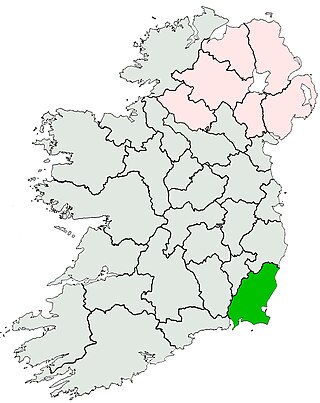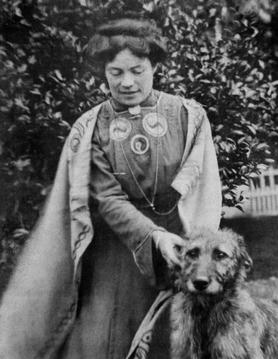
Old Norse, also referred to as Old Nordic, or Old Scandinavian, was a stage of development of North Germanic dialects before their final divergence into separate Nordic languages. Old Norse was spoken by inhabitants of Scandinavia and their overseas settlements and chronologically coincides with the Viking Age, the Christianization of Scandinavia, and the consolidation of Scandinavian kingdoms from about the 8th to the 15th centuries.

Wexford is the county town of County Wexford, Ireland. Wexford lies on the south side of Wexford Harbour, the estuary of the River Slaney near the southeastern corner of the island of Ireland. The town is linked to Dublin by the M11/N11 National Primary Route; and to Rosslare Europort, Cork and Waterford by the N25. The national rail network connects it to Dublin and Rosslare Europort. It had a population of 21,524 according to the 2022 census.

Yola, more commonly and historically the Forth and Bargy dialect, is an extinct dialect of the Middle English language once spoken in the baronies of Forth and Bargy in County Wexford, Ireland. As such, it was probably similar to the Fingallian dialect of the Fingal area. Both became functionally extinct in the 19th century when they were replaced by modern Hiberno-English. The word yola means 'old' in the dialect. In modern times, there have been efforts to revive the dialect.

The Saltee Islands are a pair of small islands lying 5 kilometres off the southern coast of County Wexford in Ireland. The two islands are Great Saltee and Little Saltee. They have been largely unoccupied since the early 20th century and have been privately owned by the Neale family since 1943. Together, the islands cover an area of 1.2 square kilometres.

The Anglo-Frisian languages are a sub-branch of the West Germanic languages encompassing the Anglic languages as well as the Frisian languages.
Fingallian or the Fingal dialect is an extinct dialect of Middle English formerly spoken in Fingal, Ireland. It is thought to have been an offshoot of Middle English, which was brought to Ireland during the Norman invasion, and was extinct by the mid-19th century. Although little is known of Fingallian, it is thought to have been similar to the Yola dialect of County Wexford.

The Norse–Gaels were a people of mixed Gaelic and Norse ancestry and culture. They emerged in the Viking Age, when Vikings who settled in Ireland and in Scotland became Gaelicised and intermarried with Gaels. The Norse–Gaels dominated much of the Irish Sea and Scottish Sea regions from the 9th to 12th centuries. They founded the Kingdom of the Isles, the Kingdom of Dublin, the Lordship of Galloway, and briefly ruled the Kingdom of York. The most powerful Norse–Gaelic dynasty were the Uí Ímair or House of Ivar.

There are a number of languages used in Ireland. Since the late 18th century, English has been the predominant first language, displacing Irish. A large minority claims some ability to use Irish, and it is the first language for a small percentage of the population.

The languages of Scotland belong predominantly to the Germanic and Celtic language families. The main language now spoken in Scotland is English, while Scots and Scottish Gaelic are minority languages. The dialect of English spoken in Scotland is referred to as Scottish English.

Kilmore or Killmore, locally pronounced 'Kilmoor', is a village in south County Wexford, Ireland, about 16 kilometres (9.9 mi) from Wexford town. Kilmore is in a civil parish of the same name.

Bargy is a barony in County Wexford, Ireland. From the 12th century Bargy and the surrounding area, including the barony of Forth, saw extensive Anglo-Norman settlement following the Norman invasion of Ireland. A distinctive Anglic language, known as the Yola language or simply Yola, was spoken in this area into the late 19th century.

County Wexford is a county located in the south-east of Ireland, in the province of Leinster. It takes its name from the principal town, Wexford, named 'Waesfjord' by the Vikings – meaning 'inlet (fjord) of the mud-flats' in the Old Norse language. In pre-Norman times it was part of the Kingdom of Uí Cheinnselaig, with its capital at Ferns.

Kathleen Anne Browne was an Irish politician, farmer, writer, historian and archaeologist. She was arrested after the Easter Rising and held in Kilmainham Gaol. During the Civil War, she was Pro-Treaty and joined Cumann na nGaedheal. She was a member of Seanad Éireann from 1929 to 1936. She was a fluent speaker of Yola, an Anglic language of Wexford.

Tacumshane or Tacumshin is a small village and civil parish in the southeast of County Wexford, Ireland. It is located 15 km south of Wexford town.

The siege of Wexford took place in early May 1169 and was the first major clash of the Anglo-Norman invasion of Ireland. The town was besieged by a combined force of Normans under Robert Fitz-Stephen and soldiers loyal to Diarmait mac Murchadha. After being ousted as King of Leinster, Diarmait had recruited the Normans to help him regain control of Leinster and the semi-independent Norse-Gaelic seaport of Wexford. Although the attackers did not breach the town's walls, Wexford surrendered after almost two days and came under Norman control.

Forth is a barony in County Wexford in Ireland.
Diarmaid Ó Muirithe was an Irish lexicographer, journalist and author.
Jacob Poole was an Irish antiquarian.














